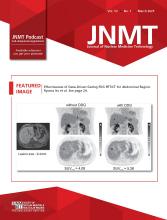Abstract
BACKGROUND: Cost-containment through indigenous development and production and its subsequent examination in clinical settings would be a pivotal step for bringing radioimmunotherapy (RIT) agents to more widespread clinical practice in non-Hodgkin’s lymphoma (NHL) patients, especially in developing countries. AIMS and OBJECTIVES: To examine the biodistribution and dosimetry of indigenously developed and radiolabeled 131I-Rituximab, using the monoclonal antibody of chimeric origin, in patients of B cell lymphoma for its potential use in RIT. MATERIALS and METHODS: This was a prospective study involving patients of B-cell NHL who underwent low dose diagnostic scan for the dosimetric and biodistribution studies. The study was presented and approved by the Institutional Scientific and Medical Ethics Committee and the product was approved by the regulatory body of DAE (Department of Atomic Energy) India, the Radiopharmaceutical Committee (RPC), for preliminary dosimetric studies. Patients with documented CD20 (Cluster Differentiation) positive NHL who were planned for and received Rituximab based chemotherapy under medical oncology supervision were recruited. Soon after the IV (Intravenous) Rituximab infusion (4-6 hrs), the small diagnostic dose of indigenously produced radioiodinated rituximab was administered by intravenous infusion. Serial planar (anterior and posterior) whole body gamma camera images were undertaken soon after the infusion (pre-void and post void) and thereafter on day 1, day 2, day 4 and day 6. All imaging were performed in Siemens Symbia dual head gamma camera equipped with 1.0 cm NaI (Tl) crystals and high-energy collimators. A 15 % energy window around 364 KeV, the dominant γ-ray energy of 131I was applied. During each whole body γ-scintigraphy, a source of 131I with known activity was used as the reference standard required for dosimetry calculations. RESULTS: A total of 13 patients have undergone assessment in this prospective study following the aforementioned study protocol. The calculated patient specific administered dose from the cumulative activity, that will give a whole-body radiation absorbed dose of 75cGy, using the MIRD (Medical Internal Radiation Dose) schema, ranged from 3095.42 to 6330.33 MBq(83.66 to 171.09 mCi), mean 3986.01±863.95 MBq(107.73±23.35 mCi) and median 3697.41 MBq(99.93 mCi). The mean residence time of this indigenous radiopharmaceutical was 69.54h. Within first 48 hours (2nd day) ≥50% of the injected activity was cleared and by 144 hours (6th day) ≥80% of the injected activity was cleared from the body in all patients. The patient-specific administered dose that would give a whole-body radiation absorbed dose of 75cGy, calculated by mean residence time and activity-hours ranged from 2654.75 to 6210.45 MBq (71.75to 167.85 mCi) mean 3576.42±927.59 MBq(96.66±25.07 mCi) and median 3421.02 MBq (92.46 mCi). With respect to organ-specific dosimetry, apart from blood pool (3.77Gy) and spleen (4.02Gy), the organs with decreasing order of mean radiation absorbed dose were lung (0.97Gy), liver (0.69Gy) and kidneys (0.7Gy) calculated for proposed therapeutic doses of the product. CONCLUSION: The indigenous product demonstrated kinetics similar in lines with that of approved commercially available radiopharmaceuticals, with advantage of less HAMA (Human Anti Mouse Antibody) response due to the pharmaceutical being a chimeric antibody rather than murine antibody and hence could be safely administered in clinical settings. In none of the organs there was dose limiting radiation exposure (≥ 20Gy) at the proposed therapeutic doses of this indigenous 131I labeled rituximab product.







